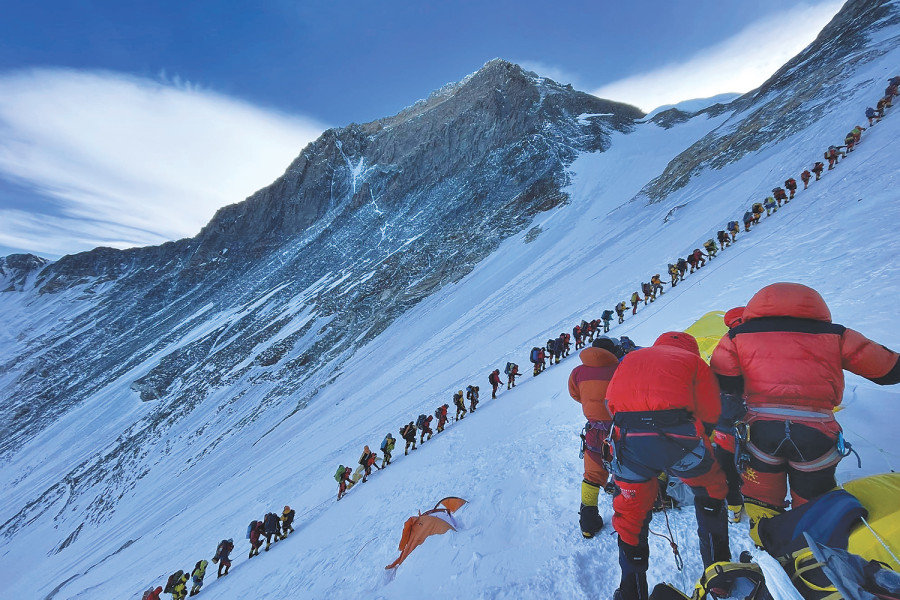Money
Everest becomes cash cow. Nepal’s top court orders limit on climbs
Expedition organisers say curbs a bad idea. Instead, they suggest making novices climb smaller peaks before Everest.
Sangam Prasain
More than 600 people, including 200 foreigners, successfully reached the summit of Everest this spring climbing season, which ended on Wednesday.
Climbers from 60 countries started a month-and-a-half-long journey from Kathmandu to Lukla, the gateway to Everest, then to base camp and the summit.
The journey brought joy to many and tears to a few who lost their nearest and dearest.
From hotels to airlines, restaurants to choppers, all saw their businesses thrive. Everest has now grown into a multimillion-dollar industry.
Nepal’s top court wants to stop this commercialisation to preserve the heritage for future generations.
Before the start of the climbing season, the Supreme Court issued a mandamus order directing the government to regulate the rising number of expeditions on the world’s tallest mountain.
A division bench of justices Sapana Pradhan Malla and Sushma Lata Mathema has ordered the government to issue climbing permits only after specifying the number of climbers and within the capacity to safely accommodate them.
The court order followed increasing traffic jams on the world’s highest peak, and the trash people leave on its slopes. Everest has even been called the ‘world's highest garbage dump’.
According to a preliminary report of the Department of Tourism, the government agency that issues climbing permits and monitors activities, eight people died on the mountain—including three who have been reportedly missing but presumed dead—this season.
Last year, according to the department, 17 people died on Everest.
Climbing guides say the 2024 spring expedition was a mix of triumph and tragedy.
Rakesh Gurung, director of the department, said there was a significant improvement in safety this year.
This year, the department issued permits to 421 fee-paying individuals to climb Everest, a significant drop from last year’s 479 permits.
Expedition agencies are also concerned about overcrowding of routes as the number of inexperienced climbers grows.
“We have asked the government on multiple occasions to make some climbing experience mandatory before one is permitted to ascend the world’s highest peak,” said Mingma G, managing director of Imagine Nepal, an expedition organiser.
“The 6,500 metres peak in Nepal or elsewhere should be made mandatory for practising as that will reduce risk. This will make the new climbers experienced before planning to take on Everest.”
“This initiative, in fact, will reduce the casualties.”
There are also other benefits of this approach.
It will promote the unclimbed peaks, increase government revenue, and generate additional jobs.
Nepal has implemented a slew of new rules in the Himalayas, including mandatory carrying of tracking devices and poo bags while summiting the peak, but has never had the rule of climbing smaller peaks before heading to Everest.
Jagat Prasad Bhusal, chief administrative officer of the Khumbu Pasang Lhamu Rural Municipality, said the rural municipality sold 1,700 poo bags. “We have received good feedback on their use and carrying back in the first year of implementing the rule.”
He said that five bodies were brought back.
The weather behaved well on Everest this season.
Expedition operators say the good weather window was open for more than two weeks.
There was no disturbance in the form of fierce wind or snow blizzard after May 19.

This year, the Icefall doctors, the experts entrusted to fix ladders at the Khumbu Icefall, the most dangerous part of the Everest climb lodged between the base camp and Camp I, shifted the path to its old course.
This dangerous section, navigated hundreds of times during the season, was changed after 10 years. Between 1953 and 2023, almost 50 sherpas died in the Icefall.
The 2014 avalanche on Everest, which killed 16 Sherpa guides, prompted authorities in 2015 to change the path to the centre to avoid the left side of the Khumbu Icefall.
“This year, the route was opened in the old section,” said Mingma Sherpa, chairman at Seven Summit Treks, who is the first Nepali as well as the first South Asian to summit all 8,000-ers in the world.
He, too, said that the best option is to ask new climbers to get some experience before they try the 8,848.86-metre Everest.
Critics say crowds are growing on Everest, causing unusual traffic jams, which often result in the death of climbers.
“But the reality is different,” said Mingma. “For example, permits were issued to 421 climbers this year, but only half of them opted to climb. Still, 600 people reached the summit. That means, for one foreign climber, two Nepali guides are mobilised,” he said. “All this is to ensure their safety.”
The casualty record in the last 10 years shows that the people who die on Everest are mostly sherpas, and the primary reason is avalanches.
Expedition organisers say climbers dying on Everest due to traffic jams is a rare incident.
In April 2014, there was an avalanche near Everest Base Camp, which killed 16 Nepali guides.
Then in 2015, avalanches set off by the devastating April 25 quake killed 20 climbers, including high-altitude guides and helpers at the base camp and the Khumbu Icefall.
In 2016 and 2017, Everest claimed the lives of six and five climbers, respectively.
This year, two foreign climbers died because they decided not to hire climbing guides or use supplemental oxygen. Similarly, a missing British climber and his Sherpa guide, who have been presumed dead, were caught in a sudden cornice fall.
“It’s not possible to bring the casualties to zero due to multiple factors, which kill people on Everest. However, by making climbers experienced, we can reduce the casualties significantly,” said Mingma Sherpa.
According to the Himalayan Database, which compiles records for all expeditions and deaths in the Himalayas, there were more than 200 deaths on the Nepal side of Everest between 1953, when Edmund Hillary and Tenzing Norgay Sherpa first scaled the peak, and 2022.
Nepal’s tourism ministry started collecting details of events on Everest from 1922 when seven Sherpa climbers died in an avalanche, becoming the first reported deaths on the tallest mountain. But it has no archive of those who lost their lives on the icy slopes.
The rising number of deaths has not dented Everest's popularity. Rather, the number of aspiring summiteers keeps growing. A record 658 climbers reached its top in the spring of 2022.
The tourism department said there were 644 successes in 2023, slightly below the 2022 figure.
The Everest season is one of the high-end tourism market segments of the country.
The 400 climbing permits generate jobs for 4,000 people, from airlines to hotels and from choppers to porters—mostly in the mountain community, where the government’s promised facilities and infrastructure are poor, according to analysts.
There were many records made this year.
Kami Rita Sherpa, a seasoned mountaineer, etched his name in history by conquering Everest for the 30th time. He climbed Everest twice this season.
Phunjo Lama, a Nepali woman, became the first woman in the world to climb Everest in the fastest time.
Lama started her ascent from the base camp, situated at an altitude of 5,364 metres, at 3:52 pm on May 22. She reached the summit of 8,848.86 metres at 6:23 am on May 23 and returned to the base camp at 4:18 pm the same day, completing the climb in 24 hours and 26 minutes.
Dawa Finjok Sherpa scaled the world's highest mountain three times in just eight days.
Poornima Shrestha, a photojournalist, became the first woman to summit Everest three times in a single climbing season, all in 13 days.
Along with success, there were deaths too.
The season’s first casualties were two Mongolian climbers. The Mongolian duo, climbing Everest without supplemental oxygen and Sherpa guides, went missing on May 13. They were found dead on May 17.
On May 21, British climber Daniel Paul Paterson and his Sherpa guide Pastenji went missing in the death zone.
“On the early morning of May 21 at around 4:40 am, climbers Paterson and Pastenji Sherpa heroically reached the summit of Everest. Tragically, during their descent near the Hillary Step at approximately 8,800 metres, they were caught in a sudden cornice fall, which impacted the group of climbers,” Lakpa Sherpa, managing director of 8K Expedition, wrote on his Facebook page.
“Despite exhaustive search efforts, we regret to confirm that we were unable to recover the bodies of Daniel and Pastenji.”
On May 22, a Kenyan climber Cheruiyot Kirui died a few metres below the Everest summit, and his Sherpa guide, Nawang Sherpa, went missing.
On May 22, Binod Babu Bastakoti, a Nepali national, died near the south Col while descending from the summit.
Indian climber Banshi Lal was rescued from Camp IV but died during treatment in a hospital in Kathmandu on May 27, according to the department.
Nearly 9,000 mountaineers have summited Everest from the Nepal side since Tenzing Norgay and the New Zealander Edmund Hillary first set foot atop the world’s highest peak in 1953.




 18.12°C Kathmandu
18.12°C Kathmandu














